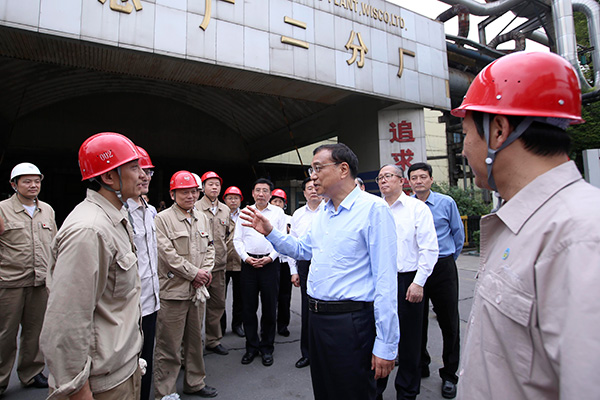
Premier Li Keqiang inspects Wuhan Iron and Steel Corp (WISCO) on May 23, 2016, stressing that enterprises should ensure redundant staffers don’t end up unemployed during the process of cutting excess production capacity. [Photo/China News Service]
Premier Li Keqiang urged State-owned enterprises (SOE) to expand reform by cutting overcapacity and improving quality and profitability at the State Council executive meeting on May 18.
On July 26, the State Council issued guidelines for further optimization of State-owned capital, and the transformation and upgrade of SOEs.
Major tasks and steps to promote the restructure and reorganization of SOEs are:
What are the targets?
-- By 2020, SOEs should have a more accurate strategic position, with their functions exerted effectively.
-- Overall structure of SOEs should become more logical, and allocation of State-owned capital should become more efficient.
-- Quality of SOEs’ development should be enhanced, forming a group of world-class multinational enterprises with innovative abilities and international competitiveness.
How to carry out restructure and reorganization
Consolidation and strengthening of security and strategy
State-owned capital should support SOEs, whose core businesses are involved in national and economic security and major national programs.
State-owned capital should have a leading position in infrastructure and strategic resource reserves.
Absolute control should be maintained in the probe of strategic natural resources, oil & gas pipeline network, electricity grid, basic data collection concerning nuclear power and geology, national defense and areas concerning national security and core secrets.
State-owned capital investment should also be strengthened in vital and major fields, such as forward-looking industries, environment protection and common technical platforms.
Innovative development
1. Build reorganization platforms
Structure and flow of State-owned capital should be optimized through effective operation.
Small SOEs and those in over-capacity industries should be operated collectively by companies invested in or operated by State-owned capital.
2. Build innovation platforms
Research platforms and basic studies should be strengthened to improve independent innovation.
SOEs should make breakthroughs in industry development and enhance integrated innovation through coordinated innovation platforms.
Internet Plus platforms should be established to promote the integration of industries and Internet with efforts to facilitate commercialization of scientific results and growth of new industries.
Participation in global innovation networks should be facilitated through international cooperation platforms.
Entrepreneurship within SOEs and the general public should be mobilized through incubation and service platforms.
3. Build international operation platforms
International competitiveness among SOEs should be enhanced through market-oriented operation.
The companies should reduce the risks of globalized operations through cluster development.
Globalized operations should also be improved through the support of various international cooperation funds, non-State-owned capital, outstanding talent and leading management systems.
Restructuring and consolidation
1. Build a strong partnership
Restructure of enterprises in fields such as equipment manufacturing, construction engineering, electric power, steel and iron, nonferrous metal, shipping, construction materials, tourism and aviation services should be promoted to efficiently cut excessive overcapacity and encourage the restructuring of SOEs.
Restructure of SOEs in coal, electricity and metallurgy should be encouraged to build competitive advantages in the production chain.
2. Promote specialized restructuring
Allocation of more resources to major and dominant enterprises should be supported through asset restructuring, equity cooperation, asset swaps and joint development.
SOEs that specialize in fields such as telecommunication, electricity, automobile, new material and non-fossil fuel should be encouraged to put more efforts into launching new technologies, new products and jointly developing new markets.
3. Speed up integration of internal resources
SOEs should be encouraged to perform professional integration by making use of methods and tools, such as capital injection and mergers.
A better management system with clear responsibilities should be promoted among the SOEs.
4. Initiate acquisitions and mergers
SOEs should be encouraged to carry out acquisitions and mergers with a focus on development strategies and a goal of attaining key technologies and core resources.
Evaluation systems for SOEs’ restructuring should be established and improved to strengthen enterprises’ business linkage and integration after M&A and promote integration of management, business, technology, market and human resources to help successful mergers or acquisitions.
Comparative advantages of each enterprise should be utilized during the acquisition and merger, and market rules should be followed.
Clean up and withdrawal
1. Cut overcapacity
Overcapacity should be cut vigorously according to the national standard on emission, environment protection, quality and security.
Investment in new projects for industries with overcapacity issues should be strictly controlled.
2. Reinforced efforts to eliminate enterprises with long-term losses or have no way of making a profit
Enterprises with losses for more than three consecutive years and that are not in line with the direction of structure adjustment should be eliminated through means such as asset reorganization and bankruptcy liquidation.
Inefficient and ineffective assets that suffer losses for more than three consecutive years and have difficulty turning a profit within two years should be disposed of through the transformation of property, asset liquidation and other means.
3. Sideline businesses with no advantage for development to be stripped
Sideline businesses and low-efficient assets that are not complementary or coordinated with the main business should be scrapped.
State-owned capital that is turned into cash should be transferred to industries and areas that require more intensive State-owned capital.
4. Resolve historical issues and separate social function from daily business
Social functions should be separated from SOEs’ operations and business.
Measures, such as transferring and government purchases, should be used to take over public service institutions that are under SOEs.
Reform for collectively owned factories operated by SOEs should be used. Social management for retirees should be standardized.
